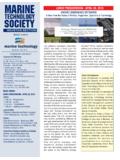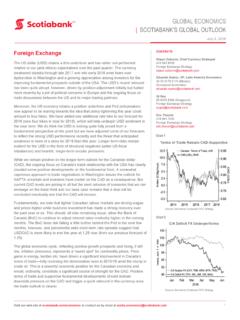Transcription of Stronger growth, but risks loom large - oecd.org
1 Stronger growth, but risks loom large ngel Gurr a OECD Secretary-General lvaro S. Pereira OECD Chief Economist ad interim OECD ECONOMIC outlook Paris, 30 May Key messages Global growth will be around 4% Investment and trade have rebounded Monetary and fiscal policies have been supportive Three quarters of OECD countries are undertaking fiscal easing Job growth has been strong The OECD unemployment rate will be at its lowest since 1980 risks loom large over the next few years: oil prices, trade tensions, financial volatility Rising interest rates will pose challenges for highly indebted countries, households and corporations. Now is the time to reform for sustainable and inclusive growth Invest in education, skills, digital infrastructure 2 A Stronger expansion Global GDP growth Contributions by regions Source: OECD Economic outlook database. -101234-10123420122013201420152016201720 182019% pts % pts ChinaIndiaUnited StatesEuro areaOther advancedOthers3 Real GDP growth Ye ar-on-y e a r, % Note: The European Union is a full member of the G20, but the G20 aggregate only includes countries which are also members in their own right.
2 1. Fiscal years starting in April. 4 OECD Economic outlook projections G e r many GDP growth Ye ar-on-y e a r, % 5 OECD Economic outlook projections has rebounded Contribution to investment growth OECD economies Note: Gross fixed capital formation, in volume. Data are year-on-year growth rates. Projections for 2018 and 2019. Source: OECD Economic outlook database; and OECD calculations. 6 -1012345-1012345201120122013201420152016 201720182019 Business and publicResidentialOECD% pts % pts Trade has recovered Growth in global trade Note: World trade is measured as goods and services trade volumes measured at market exchange rates in US dollars. Global Port Traffic is measured monthly through the RWI/ISL-Container-Throughput-Index, seasonally and working day adjusted. Projections for 2018 and 2019. Source: OECD Economic outlook database; and RWI/ISL. 7 1001071141211281351420123456201220132014 20152016201720182019 Index 2010 = 100 % y-o-y Global trade growth (lhs)Global Port Traffic (rhs)Interest rates remain low, but are beginning to rise Policy rates Actual and projections Note: Policy rates are the federal effective funds rate for the United States, the main refinancing operations rate for the euro area and the complementary lending facility rate for Japan.
3 Source: OECD Economic outlook database. 8 -10123456-10123456 United StatesEuro areaJapan% % Note: The fiscal stance is calculated based on changes in the underlying primary balance as a percentage of potential GDP. large fiscal easing is for a deterioration of the balance by more than of potential GDP and small easing is for a deterioration by less than of potential GDP. large and small fiscal tightening are defined analogously. Chile, Mexico and Turkey are excluded due to the lack of data. Projections for 2018 and 2019. Source: OECD Economic outlook database; and OECD calculations. Change in fiscal stance in OECD countries Fiscal policy is easing 0481216202428320481216202428322003200420 0520062007200820092010201120122013201420 152016201720182019 large easingSmall easingSmall tighteningLarge tighteningNumber of countries Number of countries 9 Note: Labour force participation rates and employment rates for working-age population aged 15-64 years. Unemployment as percentage of the working-age population is the difference between the two curves.
4 Source: OECD Short-Term Labour Market statistics. Job creation is strong, but there is room to bring more people into work Euro area United States Japan 10 6062646668707274767880200820132018 Unemployment Employment Labour force participation % of working-age population 6062646668707274767880200820132018 Unemployment Employment Labour force participation % of working-age population 6062646668707274767880200820132018 Unemployment Employment Labour force participation % of working-age population StatesEuro areaJapan1995-20072007-20172017-2019 (projected)% % Wage growth is picking up, but remains moderate Note: Real wage growth is calculated from nominal wage growth and the GDP deflator. Projections for 2018 and 2019. Source: OECD Economic outlook database. 11 Average annual growth in real wages per employee Inflation is set to rise moderately Inflation, excluding food and energy Note: Core inflation excludes energy and food products and refers to harmonised data for the euro area.
5 Dotted lines are quarterly projections for 2018 and 2019. The projections shown exclude the impact of the planned consumption tax hike in Japan. Source: OECD Economic outlook database. 12 StatesEuro areaJapan% y-o-y % y-o-y risks LOOM large Global demand-supply balance and oil prices Oil prices have risen significantly Note: The global demand-supply balance measures the difference between global supply and global demand, both indexed to 100 in 2012Q3, 4 quarter moving average. Oil price refers to crude oil Brent price. The last point for oil prices is the last available daily value, as of 28 May 2018. Source: International Energy Agency; Thomson Reuters; and OECD calculations. 14 demand minus supply (lhs)Oil price (rhs)USD per barrel Index Demand < supply Downward pressure on prices Demand > supply Upward pressure on prices Some emerging market economies have come under pressure EME exchange rates have depreciated recently USD exchange rate Note: Data as of 28 May 2018.
6 Source: Thomson Reuters; and OECD calculations. Depreciation since mid-April: MEX: ZAF: IDN: BRA: TUR: ARG: 15 707580859095100105110 ArgentinaBrazilMexicoSouth AfricaTurkeyIndonesiaJan 2018 = 100 Depreciation against USD Debt in foreign currency Note: Debt of non-bank borrowers in the form of bank loans and debt securities denominated in foreign currencies. Data as of 2017Q4. Source: Bank for International Settlements Global Liquidity Indicators database; and OECD calculations. A number of emerging market economies are exposed to foreign currency debt 05101520250510152025 TURMEXIDNRUSARGZAFBRACHNINDUSDJPYEUR% of GDP % of GDP 16 Note: Credit liabilities are on a non-consolidated basis. Data as of 2017Q3. Source: Bank for International Settlements; and OECD calculations. High private sector debt creates vulnerabilities Credit liabilities of non-financial corporations 17 0204060801001201401601800204060801001201 40160180 CHNFRACANJPNEAKORG20 GBRAUSUSAITATURDEURUSSAUINDBRAZAFMEXIDNA RG% of GDP % of GDP Global stock market capitalisation Source: World Federation of Exchanges; and OECD calculations.
7 Equity prices remain high despite a recent correction 18 Deep financial integration has increased exposure to foreign shocks International financial assets and liabilities Note: Sum of external assets and liabilities. Country sets vary over time depending on the availability of series for individual economies. Source: IMF Balance of Payments Statistics; OECD Economic outlook database; and OECD calculations. 19 0501001502002503000501001502002503001990 199319961999200220052008201120142017 Advanced economiesEmerging market economies% of global GDP % of global GDP A negative shock to trade would be more harmful than in the past Global exports and imports Note: Trade is the average of exports and imports in a given year. Both trade and GDP are measured in volumes in US dollars at market exchange rates. Source: OECD Economic outlook database; and OECD calculations. 20 0510152025303505101520253035199019931996 1999200220052008201120142017 Advanced economiesEmerging market economies% of global GDP % of global GDP POLICIES TO MAKE GROWTH MORE SUSTAINED AND INCLUSIVE 0510152025303540450510152025303540452011 -122013-142015-1620172011-122013-142015- 162017% % In process of implementation In process of implementation Emerging market economies Advanced economies Note: The estimated take-up of reforms is captured by the Going for Growth indicator of reform responsiveness.
8 Fully coloured bars refer to the share of fully implemented reforms. For 2017, reforms in process of implementation are shown to ensure comparability with previous 2-year periods. Emerging market economies include Argentina, Brazil, Chile, China, Colombia, Costa Rica, Indonesia, India, Mexico, Russia, Turkey and South Africa. Advanced economies include all non-emerging OECD member countries and Lithuania. Source: OECD Going for Growth. Step up structural reform ambition 22 Implementation of Going for Growth recommendations Invest in education and skills for medium-term inclusive growth 23 Note: Refers to reform priorities identified in Going for Growth in 2017 for the 46 economies covered. Source: OECD Going for Growth 2018. Take-up of reforms Share of Going for Growth recommendations 0102030405060708090100 Alignment of higher education to labour market needsSupport for disadvantaged schools and studentsTraining and language acquisition support for migrantsTeaching quality and teachers' prospectsVocational education, training and apprenticeshipsAccess and efficiency in higher educationLife-long learning and vocational educationSkill recognition and employers' information for migrants% Fully implementedIn process of implementationNo action taken in 2017 Higher reform intensity Lower reform intensity Boost job creation and business dynamism in the digital era Note: Based on up to 28 OECD countries per technology.
9 Source: OECD ICT Access and Usage by Business database. Diffusion of ICT technologies is uneven % of firms using technologies, 2016, OECD countries Improve digital and physical infrastructure Enhance R&D collaboration between universities and industry Streamline permits and licensing, cut red tape Reduce barriers to entry in professional services 24 Recommendations 020406080100020406080100medianmin-max Source: OECD Taxing Wages. Tax wedge on low income labour Average effective tax rates, 2016 Use fiscal instruments to make growth work for all Reforms to the tax and spending mix would boost output and enhance equality 25 Reduce the tax wedge on low-income earners Raise environmental taxes and recurrent property taxes Increase public investment Increase family and child allowances and subsidies for childcare MexicoKoreaCanadaUnited KingdomUnited StatesAustraliaJapanSpainTurkeyItalyGerm anyFranceBelgium01020304050% Reduce trade barriers to boost productivity and incomes Note: Scenario in which tariffs are reduced by all G20 economies to the lowest level applied across them for each sector.
10 Source: OECD METRO model simulations. 012345678012345678 WorldUnited StatesEuropean UnionChina% % ImportsExportsIncrease in trade from multilateral tariff reductions Estimated medium-term impact of lowering tariffs in all G20 economies 26 Key messages Global growth will be around 4% Investment and trade have rebounded Monetary and fiscal policies have been supportive Three quarters of OECD countries are undertaking fiscal easing Job growth has been strong The OECD unemployment rate will be at its lowest since 1980 risks loom large over the next few years: oil prices, trade tensions, financial volatility Rising interest rates will pose challenges for highly indebted countries, households and corporations. Now is the time to reform for sustainable and inclusive growth Invest in education, skills, digital infrastructure 27

















